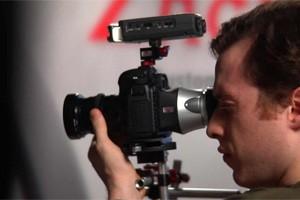
Movie sound - part 1
Have you ever wondered how actors' voices are recorded on set? Especially in very dizzying situations and under conditions that are not conducive to maintaining high quality?
There are several solutions. One of the most commonly used is the so-called poke. The directional microphone is located on a long boom, which is held in the hand of a microphone specialist. Following the actor and wearing headphones all the time, the technician tries to capture the best possible sound frame while at the same time not getting into the frame with the microphone. Not always successful - the Internet is full of videos in which Internet users mercilessly catch frames missed at the assembly stage, where the microphone hanging at the top is clearly visible.
Voice recording for animated films is the norm - after all, cartoon characters themselves do not speak ... But the same is done in the case of typical film productions.
However, there are shots and scenes in which such a configuration is not possible or the quality of the resulting sound will simply be unsatisfactory (for example, in a historical film, you will hear the noise of passing cars, the sounds of a nearby construction site, or an airplane taking off from a nearby airport). In the real world, some phenomena cannot be avoided, except when it comes to a specialized film set, which can be found, for example, in Hollywood.
Even then, due to the high expectations of the audience regarding the sound of the film, the so-called. postsynchrony. They consist of re-recording the voice on an already recorded scene and processing it in such a way that it sounds like on the set - only much better, because with interesting spatial effects and a much more attractive sound.
Obviously, it is very difficult for an actor to record phrases previously spoken on set in the studio with perfect lip-synching. It's also hard to keep the same emotions in the headphones and when watching the screen, which arose when shooting individual frames. However, modern technologies cope with such things - you only need the right tools and great experience, both of the actor himself, and of the producer and editor.
The Art of Post-Synchronization
It must be made clear right away that the vast majority of the dialogue that we hear in big-budget films is created by post-synchronous recording. Added to this are the appropriate on-set effects, omni-directional processing and very advanced editing on top-of-the-line equipment, often costing many millions of dollars. However, thanks to this, we can enjoy excellent sound, and the intelligibility of words is maintained even in the midst of a big battle, during an earthquake or strong wind.
The basis for such productions is the sound recorded on the set. This is very important because it reflects the movements of the actor's lips, although this is often not heard in the film. You can read about how this happens in the next issue of MT. Now I will try to introduce the topic of recording sound in front of the camera.
Registration of the so-called post-synchronization is carried out in specialized recording studios adapted for this type of work.
Even people unfamiliar with recording technology intuitively feel that the closer the microphone is to the speaker's mouth, the better and more intelligible the effect will be in the recording. The point is also to have the microphone "pick up" as little background noise as possible and as much of the main content as possible. Pole-mounted directional microphones work well in most situations, but are much better when the microphone is closer to a pole, for example. over the actor's clothes (assuming it's not a scene where the actor or actress is left naked...).
Then all that remains is to mask the microphone, connect it to the transmitter, which the actor also has in an invisible place, and record this signal during the frame using a receiver and recording system located outside the field of view of the camera lens. When more than one character is present in a scene, each character has its own wireless communication system and their voices are recorded on separate tracks. By recording multi-track footage in this way, you can then record post-syncs that are processed taking into account every nuance of the sound - the movement of the actor in relation to the camera, changes in the acoustics of the interior, the presence of other people, etc. Thanks to this scenario, the actor has much more freedom to play (he can, for example, tilt his head without changing the timbre of his voice), while the director is more free to design what is happening in the frame.
The job of a pole vaulter on set is not the easiest. Sometimes you have to hold the microphone high above your head for a long time - and all the time make sure that it does not go into the frame and picks up the sound as well as possible.
microphone in a tie
One microphone that works great in this situation is the Slim 4060. Its manufacturer, DPA, or Danish Pro Audio, specializes in making miniature microphones for professional use. All products are made in Denmark. This is done with miniature microphones. manually and under a microscope, and this is done by specialized and experienced employees. The Slim 4060 is a great example of a professional miniature microphone with sound that no one expects from a match head-sized capsule.
The name "Slim" means that the microphone is "flat" and therefore can be attached to various types of planes. It should be noted right away that these "planes" are usually clothing or even performer/actor body. DPA has achieved impressive results in the creation of invisible microphones. They can be hidden under clothing, in an upper pocket, in a tie knot, or in other places the professional deems appropriate. Therefore, they remain invisible to the camera, and the ability to use one of three colors, compatibility with all professional transmitter systems and the availability of a range of mounting accessories make these microphones widely used in the film and television industry.
Do you see the microphone here? Look closely at the tiny detail above the button on your shirt - this is one of the miniature DPA microphones widely used in the film industry.
The microphone cable, permanently connected to it, is specially armored and designed in such a way that it does not create any noise and interference. Of course, the most important thing here is the correct mounting of the microphone, its isolation from mechanical sources of interference and additional cable fastening a few tens of centimeters from the microphone to eliminate such problems. It all depends on the microphone players, and the manufacturer himself has done everything to facilitate their work.
The microphone has an omnidirectional characteristic (i.e., it processes sounds from different directions with the same level), operates in the range of 20 Hz-20 kHz.
The 4060 sounds great, and hiding it under clothing or moving your head has minimal impact on the sound. It's a great tool for capturing actors on set, and in some situations can virtually eliminate the need for costly post-sync. Possible correction or compression processing can be symbolic, and the sound will be easily embedded in the context of the background image. This is a first-class tool for professionals that allows you to record dialogues with the same readability as, for example, in House of Cards. Such a microphone can be bought for PLN 1730, although the investment costs for the entire recording system (wireless transmitter and receiver) will usually be 2-3 thousand more. And when we multiply this by the number of actors that need to be recorded at the same time, we add the cost of the so-called ambient microphones that record the background sound that accompanies the scene, as well as the cost of the entire recording system, it turns out that at the moment the equipment used on the set costs several hundreds of thousands of zlotys. This is serious money.
In all this, there is another factor that must be remembered - the actor or actress himself. Unfortunately, in many Polish films it is clearly seen (and heard) that young actors do not always pay attention to the correct diction, and this cannot be corrected by any microphone or the most sophisticated editing systems ...
